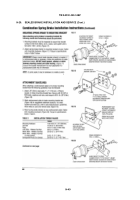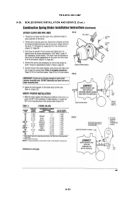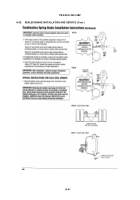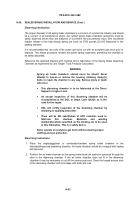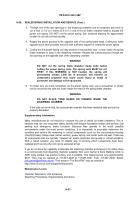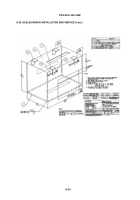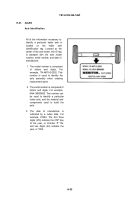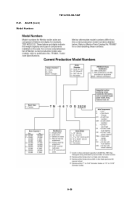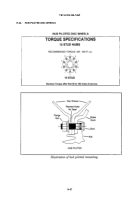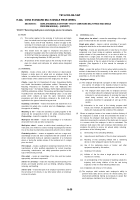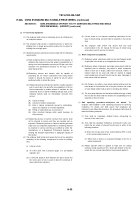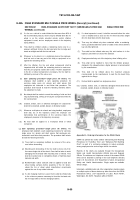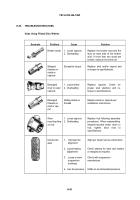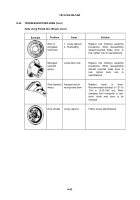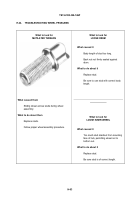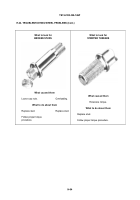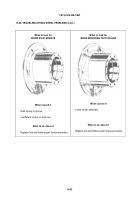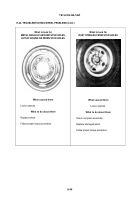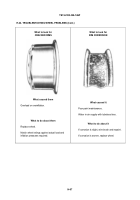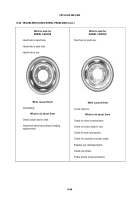TM-9-2330-326-14-P - Page 313 of 540
TM 9-2330-326-14&P
H-59
H-22A. OSHA STANDARD MULTI-SINGLE PIECE WHEEL (continued)
SECTION XV:
OSHA STANDARD 29 CFR PART 1910.177 (SERVICING MULTI-PIECE AND SINGLE
PIECE RIM WHEELS) – (EXCERPT) (continued)
(d)
Tire servicing equipment.
(1) The employer shall furnish a restraining device for inflating tires
on multi-piece wheels.
(2) The employer shall provide a restraining device or barrier for
inflating tires on single piece wheels unless the rim wheel for
inflating tires on single piece
(3) Restraining devices and barriers shall comply with the following
requirements::
(i) Each restraining device or barrier shall have the capacity to
withstand the maximum force that would be transferred to it
during a rim wheel separation occurring at 150 per cent of the
maximum tire specification pressure for the type of rim
wheel being service.
(ii) Restraining devices and barriers shall be capable of
preventing the rim wheel components from being thrown
outside or beyond the device or barrier for any rim wheel
positioned within or behind the device.
(iii) Restraining devices and barriers shall be visually inspected
prior to each day’s use and after any separation of the rim
wheel components or sudden release of container air. Any
restraining device or barrier exhibiting damage such as the
following defects shall be immediately removed from
service:
(A)
Cracks at welds;
(B)
Cracked or broken components;
(C)
Bent or sprung components caused by mishandling,
abuse, tire explosion or rim wheel separation;
(D)
Pitting of components due to corrosion; or
(E)
Other structural damage which would decrease its
effectiveness.
(iv) Restraining devices or barriers removed from service shall
not be returned to service until they are repaired and re-
inspected. Restraining devices or barriers requiring structural
repair such as component replacement or rewelding shall not
be returned to service until they are certified by either the
manufacturer or a Registered Professional Engineer as
meeting the strength requirements of paragraph (d)(3)(i) o
f
this section.
(4) The employer shall furnish and assure that an air line assembly
consisting of the following components be used for inflating
tires:
(i)
A clip-on chuck;
(ii) An in-line valve with a pressure gauge or a pre-settable
regulator; and
(iii) A sufficient length of hose between the clip-on chuck and
the in-line valve (if one is used) to allow the employee to
stand outside the trajectory.
(5) Current charts or rim manuals containing instructions for the
type of wheels being serviced shall be available in the service
area.
(6) The employer shall furnish and assure that only tools
recommended in the rim manual for the type of wheel being
serviced are used to service rim wheels.
(e)
Wheel component acceptability
.
(1) Multi-piece wheel components shall not be interchanged except
as provided in the charts or in the applicable rim manual.
(2) Multi-piece wheel components and single piece wheels shall be
inspected prior to assembly. Any wheel or wheel component
which is bent out of shape, pitted from corrosion, broken, or
cracked shall not be used and shall be marked or tagged
unserviceable and removed from the service area. Damaged or
leaky valves shall be replaced.
(3) Rim flanges, rim gutters, rings, bead seating surfaces and the
bead areas of tires shall be free of any dirt, surface rust, scale
or loose flaked rubber build-up prior to mounting and inflation.
(4) The size (bead diameter and tire/wheel widths0 and type of both
the tire and the wheel shall be checked for compatibility prior to
assembly of the rim wheel.
(f)
Safe operating procedure—multi-piece rim wheels.
The
employer shall establish a safe operating procedure for servicing
multi-piece rim wheels and shall assure that employees are
instructed in and follow that procedure. The procedure shall include at
least the following elements:
(1) Tires shall be completely deflated before demounting by
removal of the valve core.
(2) Tires shall be completely deflated by removing the valve core
before the rim wheel is removed from the axle in either of the
following situations:
(i) When the tire has been driven under-inflated at 80% or less
of its recommended pressure, or
(ii) When there is obvious or suspected damage to the tire or
wheel components.
(3) Rubber lubricant shall be applied to bead and rim mating
surfaces during assembly of the wheel and inflation of the tire,
unless the tire or wheel manufacturer recommends against it.
Back to Top

